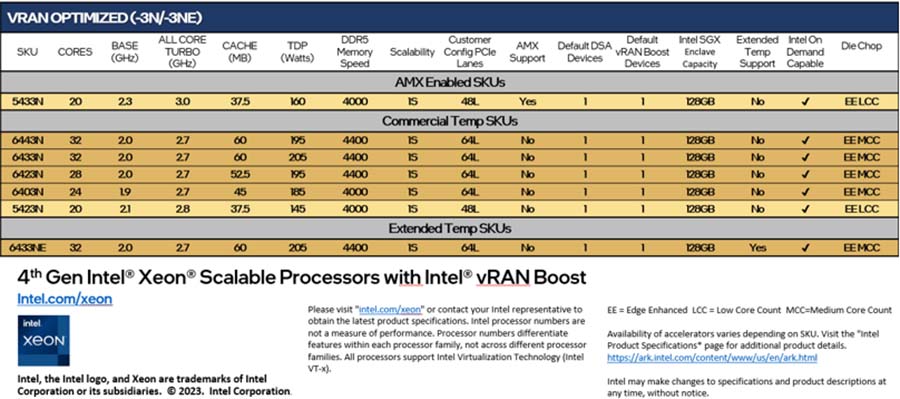Over the last decade, Intel has shown the world that virtualized radio access networks (vRANs) on general purpose processors are competitive in terms of power and performance compared to a traditional network architecture.
 By Cristina Rodriguez, vice-president and GM of Intel’s Wireless Access Network Division
By Cristina Rodriguez, vice-president and GM of Intel’s Wireless Access Network Division
Today marks a new milestone as we announce commercial availability of our latest and most integrated vRAN solution yet – 4th Gen Intel Xeon Scalable processors with Intel vRAN Boost.
First launched at MWC 2023, these processors are designed for powering high-performance, power-efficient vRANs. By fully integrating vRAN acceleration directly into the CPU, Intel has eliminated the need for an external acceleration card. This Intel vRAN Boost is a first for the vRAN market.
Eliminating the acceleration card not only reduces system complexity, but also provides substantial power savings. In fact, 4th Gen Intel Xeon Scalable processors with Intel vRAN Boost deliver up to twice the capacity and an additional approximately 20% compute power savings versus our previous generation1. That’s a gain of more than double the performance-per-watt for network operators.
These new processors also include powerful features that optimize workload performance for packet and signal processing, as well as integrated acceleration for artificial intelligence and machine learning applications.
With its combination of processing innovation and feature integration, we expect 4th Gen Intel Xeon Scalable processors with Intel vRAN Boost to match or better the performance-per-watt of the best Layer 1 SoCs in the market.
Today’s commercial introduction caps more than a year of engineering work we’ve done with numerous ecosystem collaborators to ensure market readiness, including: AWS, Canonical, Capgemini, Dell Technologies, Ericsson, Google Cloud, Hewlett Packard Enterprise, Mavenir, Microsoft Azure, Quanta Cloud Technology, Radisys, Rakuten Symphony, Red Hat, Samsung, Supermicro, Wind River and VMware.
In addition, Intel integrated numerous product design features based on feedback from Tier-1 mobile operators. We’re gratified by their enthusiastic response.
“Deutsche Telekom recently conducted a performance evaluation of Intel’s 4th Gen Intel Xeon Scalable processor with Intel vRAN Boost in our labs, and the results were very encouraging,” says Petr Ledl, vice-president of network trials and integration lab and access disaggregation chief architect at Deutsche Telekom AG.
“The tests under selected scenarios showed a 2x capacity gain using approximately 20% less power compared to the 3rd Gen Intel Xeon processor, and we expect this will also enable a reduced network infrastructure footprint among other benefits.
“Generational processing improvements are critical to the long-term growth of vRAN and Open RAN. We look forward to working with Intel and the ecosystem to drive this market forward.”
Sharad Sriwastawa, co-CEO and chief technology officer of Rakuten Mobile and acting president of Rakuten Symphony, comments: “We have collaborated with Intel since the launch of the Rakuten Mobile network in Japan.
“The introduction of 4th Gen Intel Xeon Scalable processor with Intel vRAN Boost represents the next phase of our collaboration to simplify telco operations and decrease costs with integrated acceleration and increased energy efficiency.”
“The long-term collaboration between Intel and Vodafone is key to our target of achieving 30% of our European network on Open RAN by 2030,” says Paco Martín Pignatelli, head of Open RAN at Vodafone. “4th Gen Intel Xeon Scalable processors with Intel vRAN Boost will be a strategic platform to deliver the efficiency and performance needed to deploy Open RAN in dense urban environments at scale.”
To meet the highly diverse needs of global operators, we’re offering a scalable SKU portfolio supporting a broad range of spectrum bands and deployment configurations – from massive MIMO to small cells – and extended temperatures for indoor and outdoor. Timing-enhanced Intel Ethernet 800 Series Network Adapters further reduce solution complexity and total cost of ownership by delivering critical vRAN network synchronization capabilities in a mainstream adapter.

The transformation to virtualised RAN is truly a journey. With the migration from hardware-based networks to fully software-programmable architectures well underway, there is no turning back.
As Intel’s recent collaboration announcements with Ericsson and Samsung demonstrate, we’re working closely with industry-leading RAN providers to ensure network operators have market-ready solutions to meet their unique networking requirements. We also continue to execute on a multi-generation processor roadmap focused on delivering ever-greater levels of vRAN performance, power efficiency, and feature integration.
You’ll hear a lot more about our processors with Intel vRAN Boost in the coming months, as well as more about Intel’s ecosystem collaborations to help network operators scale their vRAN and Open RAN services today, tomorrow, and on the path toward future network generations.

